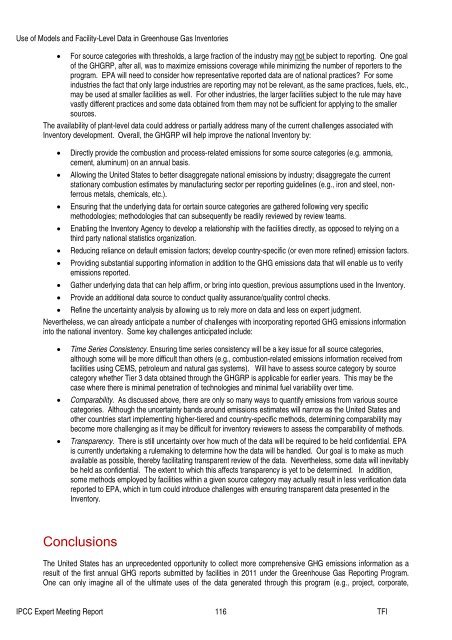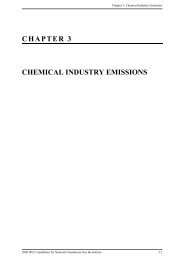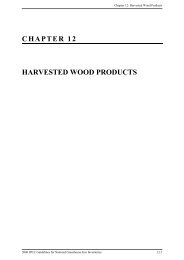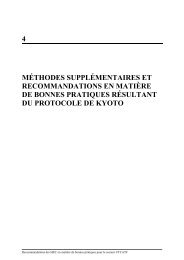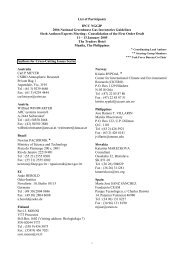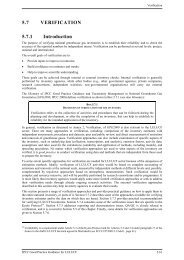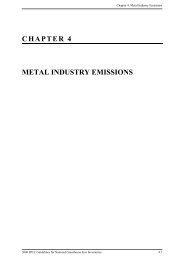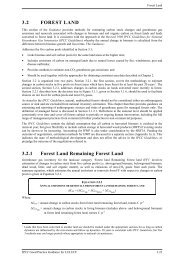Use of Models and Facility-Level Data in Greenhouse Gas Inventories
Use of Models and Facility-Level Data in Greenhouse Gas Inventories
Use of Models and Facility-Level Data in Greenhouse Gas Inventories
You also want an ePaper? Increase the reach of your titles
YUMPU automatically turns print PDFs into web optimized ePapers that Google loves.
<strong>Use</strong> <strong>of</strong> <strong>Models</strong> <strong>and</strong> <strong>Facility</strong>-<strong>Level</strong> <strong>Data</strong> <strong>in</strong> <strong>Greenhouse</strong> <strong>Gas</strong> <strong>Inventories</strong><br />
• For source categories with thresholds, a large fraction <strong>of</strong> the <strong>in</strong>dustry may not be subject to report<strong>in</strong>g. One goal<br />
<strong>of</strong> the GHGRP, after all, was to maximize emissions coverage while m<strong>in</strong>imiz<strong>in</strong>g the number <strong>of</strong> reporters to the<br />
program. EPA will need to consider how representative reported data are <strong>of</strong> national practices? For some<br />
<strong>in</strong>dustries the fact that only large <strong>in</strong>dustries are report<strong>in</strong>g may not be relevant, as the same practices, fuels, etc.,<br />
may be used at smaller facilities as well. For other <strong>in</strong>dustries, the larger facilities subject to the rule may have<br />
vastly different practices <strong>and</strong> some data obta<strong>in</strong>ed from them may not be sufficient for apply<strong>in</strong>g to the smaller<br />
sources.<br />
The availability <strong>of</strong> plant-level data could address or partially address many <strong>of</strong> the current challenges associated with<br />
Inventory development. Overall, the GHGRP will help improve the national Inventory by:<br />
• Directly provide the combustion <strong>and</strong> process-related emissions for some source categories (e.g. ammonia,<br />
cement, alum<strong>in</strong>um) on an annual basis.<br />
• Allow<strong>in</strong>g the United States to better disaggregate national emissions by <strong>in</strong>dustry; disaggregate the current<br />
stationary combustion estimates by manufactur<strong>in</strong>g sector per report<strong>in</strong>g guidel<strong>in</strong>es (e.g., iron <strong>and</strong> steel, nonferrous<br />
metals, chemicals, etc.).<br />
• Ensur<strong>in</strong>g that the underly<strong>in</strong>g data for certa<strong>in</strong> source categories are gathered follow<strong>in</strong>g very specific<br />
methodologies; methodologies that can subsequently be readily reviewed by review teams.<br />
• Enabl<strong>in</strong>g the Inventory Agency to develop a relationship with the facilities directly, as opposed to rely<strong>in</strong>g on a<br />
third party national statistics organization.<br />
• Reduc<strong>in</strong>g reliance on default emission factors; develop country-specific (or even more ref<strong>in</strong>ed) emission factors.<br />
• Provid<strong>in</strong>g substantial support<strong>in</strong>g <strong>in</strong>formation <strong>in</strong> addition to the GHG emissions data that will enable us to verify<br />
emissions reported.<br />
• Gather underly<strong>in</strong>g data that can help affirm, or br<strong>in</strong>g <strong>in</strong>to question, previous assumptions used <strong>in</strong> the Inventory.<br />
• Provide an additional data source to conduct quality assurance/quality control checks.<br />
• Ref<strong>in</strong>e the uncerta<strong>in</strong>ty analysis by allow<strong>in</strong>g us to rely more on data <strong>and</strong> less on expert judgment.<br />
Nevertheless, we can already anticipate a number <strong>of</strong> challenges with <strong>in</strong>corporat<strong>in</strong>g reported GHG emissions <strong>in</strong>formation<br />
<strong>in</strong>to the national <strong>in</strong>ventory. Some key challenges anticipated <strong>in</strong>clude:<br />
• Time Series Consistency. Ensur<strong>in</strong>g time series consistency will be a key issue for all source categories,<br />
although some will be more difficult than others (e.g., combustion-related emissions <strong>in</strong>formation received from<br />
facilities us<strong>in</strong>g CEMS, petroleum <strong>and</strong> natural gas systems). Will have to assess source category by source<br />
category whether Tier 3 data obta<strong>in</strong>ed through the GHGRP is applicable for earlier years. This may be the<br />
case where there is m<strong>in</strong>imal penetration <strong>of</strong> technologies <strong>and</strong> m<strong>in</strong>imal fuel variability over time.<br />
• Comparability. As discussed above, there are only so many ways to quantify emissions from various source<br />
categories. Although the uncerta<strong>in</strong>ty b<strong>and</strong>s around emissions estimates will narrow as the United States <strong>and</strong><br />
other countries start implement<strong>in</strong>g higher-tiered <strong>and</strong> country-specific methods, determ<strong>in</strong><strong>in</strong>g comparability may<br />
become more challeng<strong>in</strong>g as it may be difficult for <strong>in</strong>ventory reviewers to assess the comparability <strong>of</strong> methods.<br />
• Transparency. There is still uncerta<strong>in</strong>ty over how much <strong>of</strong> the data will be required to be held confidential. EPA<br />
is currently undertak<strong>in</strong>g a rulemak<strong>in</strong>g to determ<strong>in</strong>e how the data will be h<strong>and</strong>led. Our goal is to make as much<br />
available as possible, thereby facilitat<strong>in</strong>g transparent review <strong>of</strong> the data. Nevertheless, some data will <strong>in</strong>evitably<br />
be held as confidential. The extent to which this affects transparency is yet to be determ<strong>in</strong>ed. In addition,<br />
some methods employed by facilities with<strong>in</strong> a given source category may actually result <strong>in</strong> less verification data<br />
reported to EPA, which <strong>in</strong> turn could <strong>in</strong>troduce challenges with ensur<strong>in</strong>g transparent data presented <strong>in</strong> the<br />
Inventory.<br />
Conclusions<br />
The United States has an unprecedented opportunity to collect more comprehensive GHG emissions <strong>in</strong>formation as a<br />
result <strong>of</strong> the first annual GHG reports submitted by facilities <strong>in</strong> 2011 under the <strong>Greenhouse</strong> <strong>Gas</strong> Report<strong>in</strong>g Program.<br />
One can only imag<strong>in</strong>e all <strong>of</strong> the ultimate uses <strong>of</strong> the data generated through this program (e.g., project, corporate,<br />
IPCC Expert Meet<strong>in</strong>g Report 116 TFI


